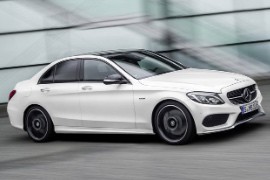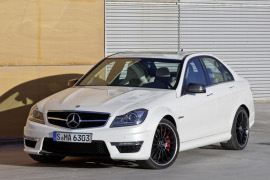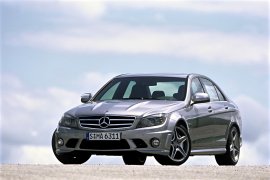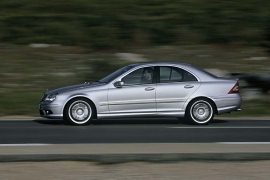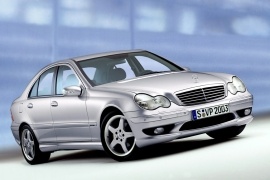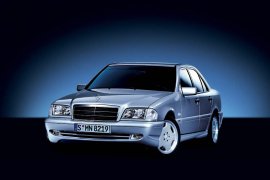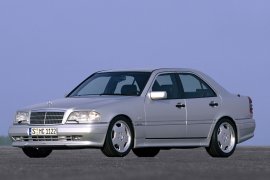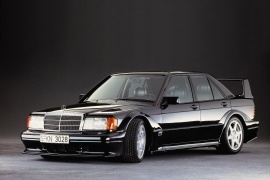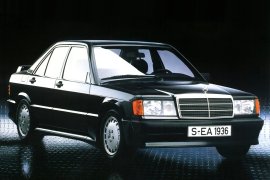MERCEDES BENZ C-Klasse AMG Models/Series Timeline, Specifications & Photos
First production year: 1984
Engines: Gasoline, Diesel
In 2014, Mercedes-Benz retired the W204 generation replacing it with the W205, which came with not one, but three AMG versions, the 450 being the least powerful of them but still with enough performance to threaten many sports cars.
The C-Class was a hugely successful model in the three-pointed-star brand lineup. Not only that it didn't look like an old man's car, but it offered a complete package of technology and performance to be considered by the younger generation, who didn't even think about a Mercedes-Benz as a sports car. And yet, the C-Class 450 AMG provided a balanced package that provided enough power and was still civilized enough to be used as a daily driver.
In the AMG version, the C-Class 450 AMG featured the specific, A-shaped, lower grille in the bumper, flanked by a pair of air-intakes that channeled the air to the front brakes. The main grill sported a 3D pattern named "diamond mesh" crossed by a single chromed bar that supported the brand's logo. At the back, a diffuser was added to the bottom of the bumper, between the two dual exhausts.
Inside, the sports seats were covered in AMG-specific upholstery and provided excellent side support during high-speed cornering thanks to the adjustable bolstered areas. In addition, the ARTICO/DINAMICA man-made leather mixed with the aluminum trims provided a sporty ambiance. Inside the instrument cluster, the carmaker placed a pair of dials with chequered flag background and red needles. In the middle, a small TFT display showed the onboard computer data.
Under the hood, AMG installed a twin-turbo 3.0-liter V6 engine paired to a seven-speed 7G-TRONIC PLUS gearbox. Power went in all corners with a front/rear 33/67 torque-split distribution.
In 2011, Mercedes-Benz introduced a facelifted version for the C-Class (W204) range and upgraded the AMG version as well.
Unlike its predecessors, the C63 AMG W204 was not just a more powerful version of the standard C-Class used by many taxi drivers around the world. It featured the front suspension from a CLK 63 AMG Black Series and a different steering system than the rest of the W204 range.
The 2011 C63 AMG featured the redesigned headlights as the rest of the range, with a swept-back look. Its grille featured a wing-type transverse louver that supported the large three-pointed-star Mercedes badge. An AMG-specific apron with a lower cross member painted in high-gloss black and unique daytime running lights adorned the side-scoops. The aluminum hood featured long powerdomes extended from the grille to the windshield's base. A carbon-fiber lip-spoiler adorned the trunk lid in the back, while four oval exhausts completed the sporty image.
Inside, the carmaker introduced a new dashboard design with an extended instrument cluster towards the passenger's side, above the center stack. Inside the tachometer, AMG placed the 6.3 V8 white letterings on black dials. The aluminum paddles shifters behind the steering wheel, which controlled the automatic gearbox when the driver selected the manual mode, were standard features for the C63 AMG.
Apart from the regular version, AMG offered a Performance Package option that squeezed 30 more ponies from the engine, raising the bar to 487 hp. The carmaker paired both versions to an AMG Speedshift MCT 7-speed sports transmission and sent the power to the rear wheels. A self-locking rear differential was on the options list to enhance the car's grip.
The top of the range C63 AMG was the most powerful version of the compact-size Mercedes-Benz. It was launched in 2007 and aimed directly at the BMW M3.
Since the battle between the BMW M3 E30 and the Mercedes-Benz 190 2.5-16, the competition between the big two German car manufacturers moved from luxury amenities to the performance factor and the power increase rises from the 200 hp range to over 400 hp range in less 20 years.
The C-Class AMG was not a subtle car. Its flared arches, aggressive front bumper, and the rear four oval exhausts screamed for attention as much as the loud V8 under the hood. With specifically designed 19” high-sheen alloy-wheels and aerodynamically profiled side-sills, the C63 AMG showed that the Mercedes-Benz does not only made comfortable cars, but it can do fast ones as well. And, if the bystander would not know exactly what was about, a 6.3 AMG silver badge was placed on each of the front fender and one on the trunk lid.
Inside, the external modifications were continued with bucket seats and other subtle changes such as aluminum pedals and trims. The instrument clustered featured four analog gauges into three dials. In the tachometer, there was a 6.3 – V8 white-on-black writing. Behind the steering-wheel, there were two aluminum paddle-shifters.
The tuned suspension ensured a better cornering speed when compared to other versions of the C-Class. On top of that, the ESP had three stages and one of them allowed some drifting. The front axle has been redesigned to allow a track increase by 35 mm (1.37”) and reduce understeer. The AMG SPEEDSHIFT PLUS 7G-TRONIC offered a blipping function to rev-match the engine while downshifting.
After Mercedes-Benz refreshed the second generation of the C-Class, the W203, it also introduced a V8-powered version signed by none other than the famous AMG team.
By 2005, all cars sold in Europe had to meet the Euro 4 emission standards, so the German automaker had to upgrade its entire vehicle lineup, including the C-Class. While most regular cars got some slight updates, the most significant change was for the gasoline-powered AMG version. While the non-facelifted W203 was available as the C 32 AMG powered by a V6 unit, the facelifted one got a massive, 5.4-liter V8 powerplant under the hood.
Dropping a V8 under the hood of a car designed to get smaller engines was not easy for Mercedes-Benz, so AMG came up with an unusual solution: to take the front end of a CLK 55 AMG and use that one instead. As a result, the C 55 AMG got a different front look than its brothers. It boasted a pair of headlights with a double-bubble design and a narrow, tilted rearward three-slat grille. The lower bumper featured a broad A-shaped air intake flanked by a pair of side scoops that housed the round fog lamps.
From its profile, the C 55 AMG looked almost identical to the rest of the W203 Phase II range. Still, there were a few details that made it look apart. The different, smoked headlights and the five double-spoked alloy wheels with larger (18-inch) diameters were distinctive. Still, it featured the same body-colored door mirror caps and handles and the rubber side stripes that crossed the doors from front to back in the median section. At the back, the short deck was adorned by a tiny lip spoiler. But the most obvious difference was seen below the bumper, where AMG installed a four exhaust system instead of a single or double one for the rest of the range.
Inside, it was the same luxurious Mercedes-Benz as in the rest of the range but with a few particular upgrades. The three-spoke steering wheel was similar to those of the rest of the facelifted C-Class W203, but the four-dial instrument cluster was slightly different. It featured silver inner trims on the speedometer and tachometer instead of the regular black ones. At the front, the automaker installed high-bolstered bucket seats with half-leather areas. As an option, customers could get them with full leather upholstery. In the back, the bench seat was good for two, even though the automaker installed three headrests and seatbelts. The middle seat provided minimal legroom due to the tall transmission tunnel.
Under the hood, AMG stuck a V8, naturally-aspirated, all-aluminum powerplant. It was carried over from the E 55 AMG and the CLK 55 AMG and sent enough oomph to the rear wheels to burn a fresh set of tires in minutes. Still, the automaker considered equipping the car with standard traction control and ESP to make its customers feel better while driving.
The second generation of the C-Class was launched in 2000. It had the new headlight theme with four rounded units instead of a square, horizontal one. And for the AMG version, the look was matched by the numbers.
After a shy start with the first generation of the C-Class, the Mercedes-Benz-AMG cooperation became stronger. As the second generation of the C-Class was launched, the C32 AMG version was launched. It was a direct threat to the BMW M3, but it was faster and it was available into three bodyworks: a sedan (mainly), station-wagon (a limited run), and sport-coupe (only by special order).
The look was quite bland. It would only take a specialist eye to notice the differences between a regular C-Class and the C32 AMG. A different spoiler, special side sills, and a lip on the trunk were the main differences. There was also a new set of 17” light-alloy wheels, but for that size, the C-Class already had other options.
Inside, there were more differences. The instrument cluster featured a silver decoration inside the big, half-moon speedometer. There were AMG badges on the gear selector and on the seats. There were no special racing seats installed. The German car manufacturer decided that its customers should enjoy the comfort of a Mercedes-Benz and the performance of an AMG in the same car.
The supercharged V6 engine offered more power and more torque than its main rival, the E46 M3. It lacked a manual transmission, but it was faster to 60 mph (97 kph).
MERCEDES BENZ C-Klasse AMG (W203) 3.2L V6 Kompressor 5AT RWD (354 HP)
The first generation of the C-Class has received an AMG improvement in 1997. It was one of the first projects for street vehicles between the AMG and Mercedes-Benz.
AMG was formed as an independent company that took MB cars and transformed it. It was the tuner next door since the AMG HQ was just a few miles away from the MB HQ. Over time, the two companies started to work on various race-models and some special projects. But the W202 C43 AMG was special because the engineers had to figure out a way to install a big V8 gasoline unit inside an inline-six engine compartment.
From the outside, there were few clues that under the hood there was an over 300 hp engine installed. There were a slightly modified front bumper and aerodynamically styled sills. The twin-oval exhaust in the rear could have been easily mistaken with an aftermarket fake tip.
Inside, the C 43 AMG featured all the goodies that a C-Class could have. There was a full leather interior, with mahogany on the dashboard. An AMG writing was embossed on the steering wheel and white backgrounds for the dials in the instrument cluster.
For the engine, the AMG installed a 4.3-liter gasoline V8 unit, which was based on the 4.3-liter unit installed on other Mercedes-Benz cars. It was modified to offer more power and torque. It was a true factory sleeper.
The 1995 C36 AMG was the beginning of the official cooperation between Mercedes-Benz and AMG for street vehicles. And the first model was successful.
Mercedes-Benz and AMG used to be different companies, with HQ situated close to each other. The two companies used to work together on various racing products, but nothing for the street use. That was until 1995 when the German carmaker sent two, brand new C280 to the AMG headquarter to modify them. And the C36 was born.
From the outside, there was a new aerodynamic package, with lower side-sills, reshaped front, and rear bumpers. On top of that, new wheels were installed on the special C 36 AMG. But the basic vehicle was a C 280.
Inside the car, there were new, bucket-seats, with leather upholstery. Since the car had to compete against the much-acclaimed BMW M3, it had to offer something different. The initial gearbox was taken from the Mercedes-Benz E500 model (same with the S500) from that era and it was a 4-speed auto. One year later, in 1996, the gearbox was replaced by a new, 5-speed auto and things got even better. The car delivered enough performances to serve as a Safety Car in Formula 1 during the 1996 and 1997 season.
Underneath the vehicle, the AMG had to use parts from Mercedes-Benz's store. But it took only from the top shelf, such as the disc brakes from the S600, which were the biggest in their inventory. A total of 5200 C 36 were produced until 1998 when the top performer C-Class model was replaced by the C43 AMG with a V8 engine.
Frustrated by the results in the DTM races, Mercedes-Benz launched the last evolution of its compact-sized sedan model in 1990, a car that became the legendary 190 E 2.5-16 Evolution II.
The late ’80s was a battle on the race tracks between Audi, Mercedes-Benz, BMW, Ford, and Opel in the German Touring Championship, or DTM for short. BMW had its M3 Evo already racing, Audi smashed the tracks with its V8 quattro model, while Ford was in charge with the Sierra Cosworth. Opel, the European arm of GM, also got some help from the same British engineering company that helped the blue-oval brand. Mercedes-Benz already had the 190 in racing trim with an engine fine-tuned by Cosworth, but it was not enough. It needed something more, so the 190 2.5-16 Evolution II was developed and introduced in 1990.
Mercedes-Benz needed the car to be faster, so it hired aerodynamics professor Richard Eppler from the University of Stuttgart to give it a helping hand. The result surprised Wolfgang Reitzle, BMW’s R&D chief, who said that the laws of aerodynamics might work differently between Stuttgart and Munchen, and if that aerodynamic kit could work, BMW should rebuild its aerodynamics tunnel. They rebuilt it. The Evo II’s front apron was lowered and shaped like it was a snowplow. On the sides, the car sported a body kit with enlarged wheel arches both front and rear and skirts that were a few inches above the ground. But the most outrageous element was the wing on the trunk that was tall and extended rearwards. The complete aerodynamic package increased the downforce on the vehicle by nearly 40%.
To get the car homologated, the automaker had to build at least 500 units of the car, so it did and gained the FIA approval to race the car. Unlike those made to run around tracks, the street versions were up to Mercedes-Benz standards in terms of features and amenities. At the front, there was a pair of high-bolstered sports seats covered in leather. The car also benefited from air-conditioning and a premium sound system. Unlike other Mercedes-Benz vehicles from that era, the Evo II featured an adjustable hydraulic suspension that could lower the car to the ground or take it higher to cross speed bumps. As a final touch, the automaker added a sunroof for standard 190 E 2.5-16 Evo II.
But the most essential upgrades were under the skin. The engine was based on the 2.5-liter M102 16V I4 developed in 1989 but had its power improved. Moreover, the red line was around 7,800 rpm, which helped the car get higher speeds. A five-speed Getrack manual gearbox with a dog-leg pattern (first gear was to the left and rearwards) was employed so drivers could gain precious seconds during races. All these efforts paid off in 1992 when the three-pointed star brand finally won the DTM championship, even if the car that won it was no longer in production.
MERCEDES BENZ 190 E 2.5-16 Evolution II 2.5 16V 5MT (235 HP)
When Mercedes-Benz introduced the M107 16V engine under the hood of the W201 in 1983, the 190 E 2.3-16 became an instant hit and the base model for race cars.
During the development program of the 190 model, codenamed W201, the German automaker considered entering into the World Rally Championship. But all those ideas were abruptly changed when Audi launched the S1 quattro and dominated races. Mercedes-Benz understood that its rear-wheel driven car wouldn't stand a chance against the mighty all-wheel drive turbocharged machinery from Ingolstadt. As a result, it focused on circuit racing and developed the 2.3-liter 16-valve powerplant together with Cosworth Engineering. The engine block was the same as the one installed in the 2.3-liter 8 valves but with a cylinder head built in the United Kingdom and shipped to Germany for final installation.
Besides the technical upgrades, there were significant improvements in the car's aesthetics. When Bruno Sacco penned the 190 lineup, he knew it would get a sportier version, so he was prepared to alter the vehicle's shape to match the powerplant's performance. As a result, the 2.3-16 version was slightly different in terms of styling, and every change he made was to improve its performance and aerodynamics.
At the front, the car featured a lower air dam that wasn't tilted rearward like in the rest of the range, but it was almost vertical and sported a chin underneath it. On the door panels and fenders, the automaker placed bodycolor molding extended downwards with side skirts that also blocked the air and diminished the ground effect that slowed the car. Finally, at the back, Mercedes-Benz completed the aerodynamic package with a small wing on the trunk and a bumper extended with an apron to lower the drag resistance. All these modifications led to a Cd of just 0.32, which was excellent for those times.
Inside, the 190 E 2.3-16 received a luxurious interior. At the front, the automaker installed sports seats with high-bolstered areas and standard leather upholstery, while at the back, the car had a bench seat profiled for two passengers. There was no room for a third person there. Vehicles sold in the U.S. came with just three options: heated seats, sunroof, and rear headrests. In front of the driver, the automaker placed the same instrument panel as in the rest of the 190 E range, but it added two gauges and a stopwatch on the lower side of the center stack.
The 190 E 2.3-16 was available with a five-speed manual gearbox that featured a dog-leg pattern, meaning that the first gear was lower to the left instead of upper to the left as in most of the manual transmission transmissions, and all vehicles came fitted with a limited-slip differential. The European version of the 190 E 2.3-16 offered 185 PS (183 hp) instead of just 169 PS (167 hp) for the U.S. model due to stricter emissions standards.
The 190 E 2.3-16 paved the way for the German automaker to have a strong relationship with the AMG racing company, which later became an official supplier of Mercedes-Benz high-performance cars and, starting in 1999, part of the three-pointed star company.
